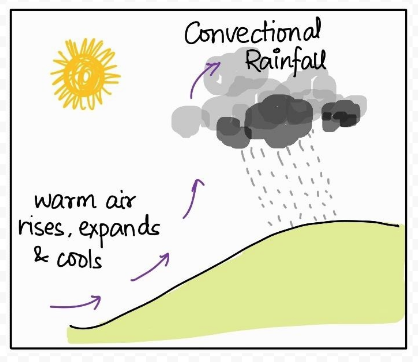![]() 29 Nov 2023
29 Nov 2023
The world above is adorned with the ethereal beauty of clouds, those mesmerizing formations that dance across the sky, revealing the dynamic interplay of water vapor and atmospheric conditions in the Hydrological Cycle. Clouds, ranging from delicate cirrus to imposing cumulonimbus, offer a fascinating spectacle, each type holding its unique characteristics dictated by altitude, size, and density. In this article, we embark on a journey through the clouds, discovering their distinct features and the phenomena they give birth to—precipitation.
On the basis of origin, rainfall may be classified into three main types – the convectional, orographic or relief and the cyclonic or frontal.

The description provided pertains to convectional rainfall, a phenomenon intricately linked to the Hydrological Cycle:
This type of rainfall is a significant component of the hydrological cycle and is important for maintaining water sources in many regions.
The type of rainfall described is known as relief or orographic rainfall, intricately connected to the Hydrological Cycle:
This type of rainfall is commonly observed in regions with significant mountain ranges and plays a crucial role in influencing local climate and ecosystem distribution through the Hydrological Cycle.

The distribution of annual rainfall on Earth is influenced by a variety of factors within the Hydrological Cycle, including latitude, proximity to oceans, prevailing wind patterns, and topography.
Based on these factors, annual precipitation zones can be categorized as follows:
Understanding these patterns is crucial for agriculture, water resource management, and ecosystem distribution in different regions around the world.
Water cycle: The continuous transformation and circulation of water among oceans, the atmosphere, and land is referred to as the water cycle.
Humidity: Water vapor present in the air is known as humidity.
Evaporation: A process by which water is transformed from liquid to gaseous state.
Condensation: The process of transformation of water vapor into water is called condensation.
Cumulus Cloud : Large clouds with relatively flat bases. These are found in an altitude range from 300 – 2,000 m.
Precipitation: Release of moisture that occurs after the condensation of water vapor.
Hailstones: It is a type of precipitation received in the form of ice pellets or hail stones. The size of hailstones can be between 5 and 190 mm in diameter.
<div class="new-fform">
</div>
